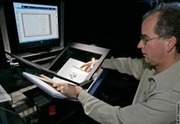Principles Of Radio Communication
Bookreader Item Preview
Share or Embed This Item
texts
Principles Of Radio Communication
- by
- Morecroft, John Harold, 1881-1934; Pinto, A. (Assistant chief engineer, Otis Elevator Co.); Curry, W. A. (Walter Andrew)
- Publication date
- 1921
- Usage
- Public Domain Mark 1.0


- Topics
- Radio, Ham Radio, Amateur Radio, Boatanchor
- Publisher
- New York, John Wiley & Sons; [etc.]
- Collection
- folkscanomy_hamradio; folkscanomy; additional_collections; dlarc; americana
- Language
- English
- Item Size
- 2.0G
CHAPTER I
Fundamental Ideas and Laws
Electrons — Electric fields — Induced charges — Electric current — Conductors and insulators — Continuous and alternating current — Wave shape — Magnetic fields — Units — Induced e.m.f. — Self-induction — Coupling — Capacity — Oscillograph — Current flow in inductive and condensive circuits — Time constant — Alternating-current flow in various circuits — Effect of frequency — Transients in inductive circuits — Resonance — Decrement — Decrement from resonance curve — Parallel circuits — Various types of coupling — Effect of neighboring circuits on resistance and reactance — Resonance in coupled circuits — Resonance in electrically long circuits 1-110
CHAPTER II
Resistance — Inductance — Capacity
General concept of resistance — Various factors affecting resistance — Skin effect and its elimination — Skin effect in coils — Eddy currents in iron cores — Characteristics of iron core coils — Resistance of arc and spark — Resistance of an antenna.
Coefficient of self-induction — Self-induction of single vertical wire — Single horizontal wire — Single circular turn — Single layer solenoid — Flat spiral — Toroid — Single layer square coil — Flat square coil — Multilayer coil — Mutual induction of two single turns — Coaxial solenoids — Two- wire antenna — Two concentric coils — Two coaxial spirals.
Capacity in general — Capacity of an isolated sphere — Parallel circular plates — Single vertical wire — Mutual capacity of two horizontal wires — Multiplate condenser — Forms of condensers — Specific inductive capacity — Losses on condensers — Phase difference of a condenser — Internal capacity coils — Natural period of coils. 111-178
CHAPTER III
General View of Radio Communication
Wave motion in water — Electro-magnetic waves — Velocity of propagation — Different types of waves — Spark telegraphy — Continuous-wave telegraphy — Radio telephony — Receiving station — Selectivity — Interference — Simultaneous sending and receiving — Atmospheric disturbance — Elimination of atmospheric disturbance — Attentuation of waves — Day and night variation in signal strength — Seasonal variation — Amounts of power required — "Freak" transmission 179-201
CHAPTER IV
Laws of Oscillating Circuits
Condenser discharge through inductance — Effect of condenser leakage — Frequency — Wave-length — Voltage and current relations — Damping and decrement — Decay of current, voltage and energy — Effect of spark gap — Number of waves in a train — Effective value of damped sine wave current — Effect of neighboring circuits upon oscillatory discharge — Coupled pendulums — Oscillations in coupled circuits — Phases and amplitudes of currents — Vector diagram of currents in coupled circuits — Frequency of beats — Quenching gap — Oscillatory circuit excited by continuous voltage — Oscillatory circuit excited by application of alternating voltage — Periodic disturbances in oscillatory circuit — Oscillatory circuit excited by pulse — Impulse excitation of parallel resonant circuit — Oscillatory circuit excited by damped sine wave and resonance curve for such a case 202-274
CHAPTER V
Spark Telegraphy
Normal transmission equipment — Battery and coil — Alternators for radio transmitters — Transformers — Condensers — Resonance conditions in audio frequency circuit — Different types of spark gaps — Oscillation transformer — Energy distribution curves of a transmitter and effect of coupling — Adjustment of a spark transmitter — Elements of a receiving set — Need of a rectifier — Types of coupling — The telephone receiver — Crystal rectifiers — Vacuum tube detector — Adjustment of receiving set — Wave-lengths and ranges of transmission in spark telegraphy — Arrangement of apparatus in typical transmitting stations 275-363
CHAPTER VI
Vacuum Tubes and Their Operation in Typical Circuits
Possibility of electron emission — Theoretical prediction of electron evaporation — Electron atmosphere — Power required to produce emission — Two-electrode vacuum tube — Fleming valve — Space charge and its effects — Three-electrode tube — Deforest audion — Potential distribution in three-electrode tube — Uses of three-electrode tube — Operating limits of a tube — Effect of gas — Ionization — Evacuation of a tube — Detection of gas in a tube — Characteristic curves of typical three-electrode tubes — Free grid potential — Equation of plate current — Resistance of tube circuits — Capacity of input circuit — Three-electrode tube as detector — Action of grid condenser — Triode as generator of alternating current power — Output and efficiency — Heating of plates — Phase relations in a triode — Possibility of self-excitation — Triode as detector of continuous wave signals — Analysis of typical circuits used for self-excitation with conditions necessary for oscillation — Starting and stopping oscillations — Parasitic frequencies — Circuits used with triode as detector — Criterion for oscillation in detector tube — Peculiar noises in autodyne circuits — Regenerative circuits for spark signal reception — Triodes in parallel — Alternating-current power supply for plate circuit — Special forms of tubes — Detailed study of triode as power converter — Triode characteristics when used as amplifier 364-577
CHAPTER VII Continuous-wave Telegraphy
Advantages of continuous-wave telegraphy — High-frequency generators — Poulsen arc — Elementary theory of oscillating arc — Types of oscillation of arc — Commercial form of arc — High-frequency alternators — Alexanderson alternator — Goldschmidt alternator — Frequency transformers using iron cores — Marconi multiple-gap generator — Methods of signaling used with different generators — Reception of continuous-wave signals — Tone wheel — Heterodyne — Effect of upper harmonics on beat reception — Arrangement of apparatus in continuous-wave tube transmitters 578-645
CHAPTER VIII
Radio Telephony
Field of use — The transmitter — The receiver — Modulation — The microphone transmitter — Analysis of modulation — Percentage modulation — Schemes for modulation — The vacuum tube in radio telephony — Heising scheme of modulation and its analysis — Alexanderson scheme of modulation — Analysis of modulated wave — Oscillating tube as receiver — Effect of decrements upon quality of speech — Multiplex radio telephony — Amounts of power used and distances covered — Arrangement of apparatus in a commercial set — Simultaneous transmission and reception 646-693
CHAPTER IX
Antennae and Radiation
Radiation from simple antenna — Effects of moving electric and magnetic fields — Open and closed electric systems — Fields involved in radiation — Radiated field at a distance from the antenna — Radiation from a coil — Excitation of the transmitting antenna — Various types of antennae and their characteristics — Relation between simple antenna and coil antenna — Antennae for air ships — Underwater antennae — Ground antennae — Law of radiation from an antenna — Radiation resistance — Current in receiving antenna — Merits of different types of antennae — Limitation of transmission formulae — Counterpoises — Antenna resistance — Natural wave-length of an antenna — Current and voltage distribution along an antenna and effect of loading — Direction finders — Reliability of direction finders — Transient effects in an antenna 694-780
CHAPTER X
Wavemeters and Their Use
Frequency and wave-length — Principle of wavemeter — Extending range of a wavemeter — Schemes for indicating resonance — Classification of resonance indicators — Condenser for even scale — Autodyne wavemeter — Measuring the wave-length of a transmitter — Energy distribution — Decrement determination with spark transmitter — Determination of decrement of wavemeter — Decremeter — Measurement of constants of an antenna — Mutual induction and coefficient of coupling determination — An improvised wave-meter 781-823
CHAPTER XI
Amplifiers
Amplifiers in general — Characteristics of triodes — Effect of plate circuit resistance and reactance — Classification of amplifiers — Transformer-repeating amplifiers — Construction of transformers for audio-frequency — Impedance of telephone receivers — Connections of transformer-repeating amplifier — Transformer-repeating amplifiers for high frequencies — Resistance amplifier — Proper resistances for repeating — Grid condenser and leak — Inductance-repeating amplifier — Filters and their characteristics — Stability of amplifiers — Tube noises — Arrangement of apparatus in amplifiers 824-879
CHAPTER XII
Radio Experiments
Resonance curves — Buzzer-generator and crystal detector characteristics — Study and use of wavemeter — Setting up and adjusting a spark transmitter — Measurement of antenna constants — Continuous current characteristics of three-electrode tube — Three-electrode tube as detector of damped waves — Determination of tube constants — Triode as power converter — Triode as source of power in self-exciting circuit — Resistance measurements at high frequency — Oscillating triode as receiver of continuous-wave signals — Study of the audio-frequency amplifier — Study of radio-telephone set 880-919
Digitized by Google.
Electronic reproduction
Master and use copy. Digital master created according to Benchmark for Faithful Digital Reproductions of Monographs and Serials, Version 1. Digital Library Federation, December 2002
digitized
Description based on print version record
Electronic reproduction
Master and use copy. Digital master created according to Benchmark for Faithful Digital Reproductions of Monographs and Serials, Version 1. Digital Library Federation, December 2002
digitized
Description based on print version record
- Addeddate
- 2016-02-29 05:50:16
- Coverleaf
- 0
- Foldoutcount
- 0
- Identifier
- PrinciplesOfRadioCommunication
- Identifier-ark
- ark:/13960/t8ff82602
- Ocr
- ABBYY FineReader 11.0
- Ocr_converted
- abbyy-to-hocr 1.1.7
- Ocr_module_version
- 0.0.13
- Openlibrary
- OL25893901M
- Openlibrary_edition
- OL25893901M
- Openlibrary_work
- OL7872657W
- Page_number_confidence
- 100
- Page_number_module_version
- 1.0.3
- Pages
- 959
- Ppi
- 600
- Scanner
- Internet Archive HTML5 Uploader 1.6.1
- Worldcat (source edition)
- 609163702
- Year
- 1921
- Full catalog record
- MARCXML
comment
Reviews
6,163 Views
20 Favorites
DOWNLOAD OPTIONS
IN COLLECTIONS
Folkscanomy: Ham and Amateur Radio Folkscanomy: A Library of Books
Folkscanomy: A Library of Books
 Additional Collections
Additional Collections
 Digital Library of Amateur Radio & Communications
Digital Library of Amateur Radio & Communications

Uploaded by Unknown on
 Live Music
Archive
Live Music
Archive Librivox
Free Audio
Librivox
Free Audio Metropolitan Museum
Metropolitan Museum Cleveland
Museum of Art
Cleveland
Museum of Art Internet
Arcade
Internet
Arcade Console Living Room
Console Living Room Open Library
Open Library American
Libraries
American
Libraries TV News
TV News Understanding
9/11
Understanding
9/11
